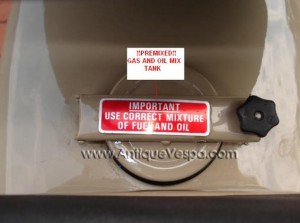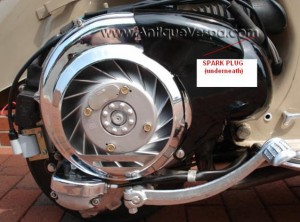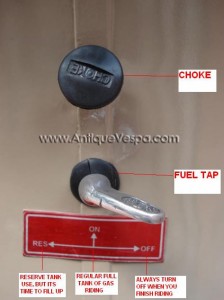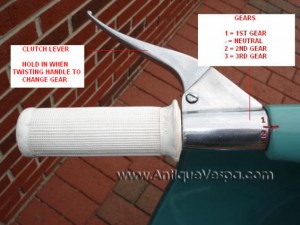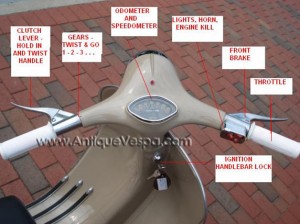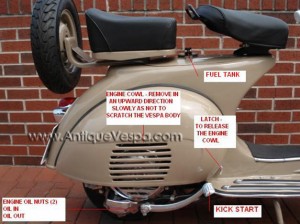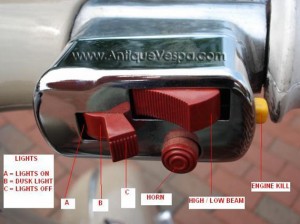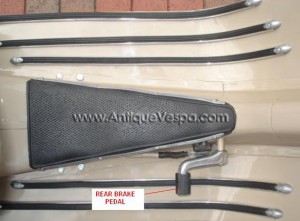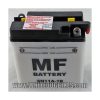Courtesy AntiqueVespa.com
OPERATING & MAINTENANCE
Before cruising your new scooter, please get yourself familiar with the following features; it is also extremely important to remember the following rules:- Break In Your Engine for maximum performance, reliability and longevity! No matter how well and careful an engine is rebuilt, it must have a break-in period, so be gentle for first 100 miles or so – Break-in is necessary!
Cruise slowly, shifting gears, test brakes for the first 100 miles enabling all new parts to adjust themselves to each other, especially Piston, rings and Cylinders. 1. Your Vespa may or may not arrive with pre-mixed gas / oil mix in the fuel tank.
Take a look in the gas tank, and see if there is any remaining from our road testing. If there is no sign of gas in the tank, you need to make your gas and oil mix. EXAMPLE – 1 USA GALLON UNLEADED GAS needs just under 100ML of two stroke oil mixed into it, mix well. (Preferably 2 stroke synthetic oil) Most oil bottles sold at stores have the ML gauge on the side, use this to measure your mix.
2. Your Vespa has remained motionless for a while, so it is advisable to perform the following task before starting the engine – Remove right cowl where the engine is located, remove the spark plug, pour 50ML of two stroke synthetic oil into the spark plug hole (Use a long funnel applicator) Tighten the spark plug back into it’s socket, place the gold clips back around the top of the spark plug, and put the cowl back over the engine. (This will lubricate the pistons and bearings for a better and smoother performance)
3. Make sure your Fuel Tap switch is in the “On” position, the Tap points up to the sky. When you have to use Reserve gas (R), it’s advisable to begin looking for a Gas station and fill up with Gas.
(Don’t forget to mix 2-4% of two stroke synthetic motor oil, preferably synthetic, and any unleaded gas is usable) EXAMPLE – 1 USA GALLON UNLEADED GAS needs just under 100ML of two stroke oil mixed into it, mix well. (Preferably 2 stroke synthetic oil) Most oil bottles sold at stores have
4. Pull out the choke tap which is located above the fuel tap; kick start a few times until it starts (Be patient, your vespa has been sitting in transit for a while). When it’s running, push the choke in before cruising. Always warm up the engine before riding at full speed.
5. Always make sure the gear is in ‘Neutral’ position before starting the engine (move gears dot-to-dot, not dot to number). Squeeze the clutch lever before shifting gears, just like operating a manual transmission in your car.
Square button is ‘Engine Kill’ switch, this will stop engine completely.
Round button is for horn. Tee-tee is the original sound (soft sound not like the modern LOUD horns of today)
Front brake lever is positioned on the right side of handle bar. The rest of the switches are for lights.
Baggage / Glove Box – It’s useful to keep various tools in here.
Spark plug wrench, spark plug, screw-driver, socket wrench for removing wheels if you get a puncture, flashlight, engine starter spray (to spray down spark hole if vespa won’t start), premixed auxiliary fuel, clean rag, funnel, registration & insurance documents etc.
Remember, we provide you with many freebies which will be located in this compartment upon delivery. (Be careful not to damage any of the wires / fuses or switches that may be located in this particular compartment)
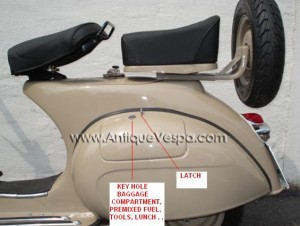
BREAKING IN THE ENGINE
Operation:
The most important period in the life of your scooter is the first 1250 miles. The engine may be brand new and different moving parts of the engine need to be set to their correct operating tolerances. This ensures a longer life for your scooter, therefore it is necessary to take some precautions so as not to overload the engine.
Keep to the following speed limits
1st Gear : 0 to 6 miles/hr
2nd Gear : 6 to 12.5 miles/hr
3rd Gear : 12.5 to 22 miles/hr
4th Gear : 22 miles/hr and above
Vary the speed from time to time.
- Avoid excessive high rpm use “in any gear”
- Avoid running the scooter on full throttle for long periods.
- Allow a cooling off period of 5-10 minutes after each hour of use.
- Maintain oil level in gear box up to recommended level.
- Check plug color for proper jetting
Every location is going to have different tuning characteristics altitude and temperature have major impacts on engine jetting
The hotter it is the less fuel you need – jet #
The cooler it is the more fuel you need + jet #
The higher altitude you go less fuel -jet #
The lower SEA LEVEL more fuel +jet#
This engine comes with a 94 main jet
This works for an average 80o at 5000ft
You want a spark plug with an electrode color of light brown, this shows proper mixture for your area / altitude:
Black Spark Plug: Too rich, White: too lean, Tan: just right!
This is for the main jet setting only. The idle mixture is on the rear of the carburetor, this adjusts the mixture at idle and 1/8 throttle opening. Most bikes will be within 1.5 to 3 turns out, set this after the bike warms up by adjusting it in and out to find the highest idle rpm. Then set idle speed with the air speed screw on the top of the carburetor to 950 to 1200 rpm.
